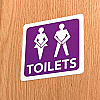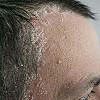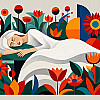Rosacea
- Reviewed by Howard E. LeWine, MD, Chief Medical Editor, Harvard Health Publishing; Editorial Advisory Board Member, Harvard Health Publishing
What is rosacea?
Rosacea (rose-ay-shah) is a common, long-lasting skin condition that causes inflammation and redness of the face. It usually starts with redness on the cheeks and nose, and also can affect the forehead and chin. The late comedian W.C. Fields, who was known for his wicked wit and red, bulbous nose, had an advanced case of rosacea.
|
|
Rosacea tends to affect fair-skinned adults between ages 30 and 50 who have "peaches and cream" complexions and a history of blushing easily. Women develop rosacea more often than men, but men are more apt to develop lumpy, enlarged noses, a condition called rhinophyma. Rosacea often is mistaken for sunburn and often goes undiagnosed. It is a very treatable condition.
Symptoms of rosacea
There are four progressive stages of rosacea:
- First stage — Flushing and intermittent facial redness
- Second stage — Persistent redness on the cheeks, nose, chin or forehead
- Third stage — Small, pus-colored or red bumps, along with tiny blood vessels that appear as red, thin lines called telangiectasias
- Fourth stage — Bumps and skin thickening of the nose.
Here's a detailed look at the most common symptoms of rosacea.
- Redness — Facial skin redness looks like a sunburn or blush. This is caused by flushing, which occurs when excess blood rapidly flows through the skin's blood vessels and the vessels enlarge to handle this flow. Gradually, this redness becomes more noticeable and does not go away. Facial skin also may become very dry.
- Pimples and Papules — Small, red and solid "papules" or pus-filled "pimples" may appear on the face, similar to those found in teen-age acne. In fact, rosacea has often been nicknamed adult acne or acne rosacea. Rosacea has different causes than acne, however, and adults with rosacea do not have the whiteheads or blackheads (called comedones) commonly seen in acne.
- Red lines (telangiectasias) — Facial blushing or flushing causes small blood vessels to expand and eventually to show through the skin. These enlarged blood vessels appear as thin red lines (telangiectasias) on the face, especially on the cheeks. At first, telangiectasias may be hidden by the redness of flushing or blushing, but they usually reappear after this redness fades.
- Nasal bumps — Left untreated, rosacea eventually can create small, knobby bumps on the nose, which make the nose appear swollen. This condition is more common among men and is called rhinophyma.
- Eye irritation — Red, dry eyes develop in about half of people with rosacea. Eye involvement is usually relatively mild. Rarely, severe involvement of the eyes develops. If untreated, it can affect vision.
Diagnosing rosacea
A doctor usually can diagnose rosacea based on the history of flushing and the appearance of your skin. In the early stages of rosacea, the rash sometimes can be mistaken for sunburn, acne, hot flashes of menopause or allergy to cosmetics.
Expected duration of rosacea
Symptoms of rosacea commonly come and go in cycles, often triggered by substances and situations that make the face flush. By seeking medical help early and adhering to medical treatments, you can improve your skin condition and perhaps stop, or reverse, the progress of this condition.
Preventing rosacea
Although a recent study found fewer cases of rosacea among people who drank caffeinated coffee, there is no proven way to prevent rosacea. The symptoms may be reduced by recognizing these common triggers: hot drinks, alcohol, spicy foods, stress, sunlight, extreme heat or cold. These conditions increase blood flow and cause the small blood vessels in the face to widen (dilate). If you have rosacea, try to identify your particular triggers and either modify them or avoid them entirely.
To cleanse and moisturize your face, you should select facial products that do not burn, sting, irritate or cause redness when they are applied. You should wash your face with lukewarm water and a mild soap, using your fingertips to apply the soap gently. You should avoid toners, astringents, scrubs, exfoliating agents and products that contain alcohol or acetone. Hydroxy acids and tretinoin (for example, Retin A) may sensitize the skin to sun and can worsen rosacea.
Sunscreens and sun blockers should be used regularly and liberally to protect the face. Use sunscreens with SPF factor of 30 or higher. If chemical sunscreens cause stinging, switch to physical sun blocks, which contain titanium or zinc oxide.
Treating rosacea
Depending on your symptoms, your doctor may prescribe the following:
- Brimonidine (Mirvaso) or oxymetazoline (Rhofade) – These topical medications constrict blood vessels and may work best for the facial redness of rosacea.
- Topical antimicrobials — Topical metronidazole cream or gel (MetroCream, MetroGel) and is the most frequently prescribed first-line therapy. Other options include topical ivermectin (Sklice or Soolantra) or sodium sulfacetamide (Klaron and others), especially for rosacea manifest by pimples and papules.
- Azelaic acid —It is a topical gel containing dicarboxylic acid and is used for the inflammatory pimples of mild to moderate rosacea.
- Oral antibiotics -- Tetracycline and tetracycline derivatives, such as doxycycline, are prescription drugs taken by mouth once or twice per day. They are sold under several brand names. Improvement is usually noticeable within the first two months after beginning treatment.
- Beta-blockers and alpha antagonists — These medications may reduce flushing through their effect on blood vessels. Propranolol (Inderal) and nadolol (Corgard) are beta-blockers, and clonidine (Catapres) is an alpha antagonist. The use of these drugs for rosacea is off-label, meaning that the FDA has not approved their use for rosacea. Beta-blockers usually are used to treat high blood pressure and heart disease. Clonidine was developed to treat high blood pressure, but also is used to decrease hot flashes in menopause.
- Estrogen — When prescribed for other menopausal symptoms, this female hormone may help when rosacea is aggravated by the hot flashes of menopause. The smallest dose of estrogen that controls menopausal symptoms should be used, then the hormone should be stopped when hot flashes no longer occur.
- Laser treatment — This is used to get rid of dilated blood vessels or to remove excess nose tissue.
- Surgical procedures — Surgical shave techniques or dermabrasion can also be helpful in removing excess nose tissue in rhinophyma.
When to call a professional
Contact your doctor if you notice a persistent facial blush, or if your complexion shows persistent pimples and red, dry, scaly blotches. Also call your doctor if you suspect that constant redness on your cheeks is not caused by sunburn or by your tendency to blush easily. Remember, it's easy to misdiagnose rosacea as acne, and using nonprescription acne medications may worsen your rosacea by irritating skin that is already dry and sensitive.
Prognosis
The progression of rosacea varies from person to person, depending on factors such as genetics, skin sensitivity, skin complexion, length of time spent in sunlight without sunscreen, consumption of alcohol and spicy foods, and exposure to extreme hot and cold temperatures. With appropriate treatment and avoidance of triggers, rosacea generally can be well controlled.
Additional Info
National Rosacea Society
https://www.rosacea.org/
American Academy of Dermatology
https://www.aad.org/
About the Reviewer

Howard E. LeWine, MD, Chief Medical Editor, Harvard Health Publishing; Editorial Advisory Board Member, Harvard Health Publishing
Disclaimer:
As a service to our readers, Harvard Health Publishing provides access to our library of archived content. Please note the date of last review or update on all articles.
No content on this site, regardless of date, should ever be used as a substitute for direct medical advice from your doctor or other qualified clinician.
















